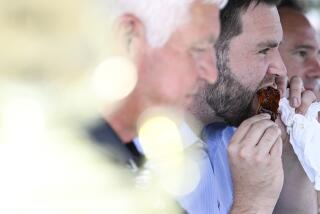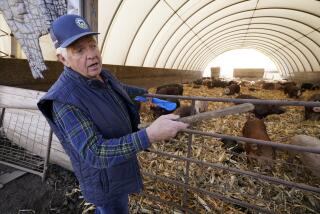Puck says it’s time to hold the foie gras
- Share via
Celebrity chef Wolfgang Puck and the Humane Society of the United States plan to announce today that Puck’s $300-million-a-year food empire is beginning a program to fight animal cruelty.
If the plan is carried out as promised, it means no foie gras -- fatty liver produced by overfeeding ducks and geese -- would be served at Spago or any of Puck’s 14 other fine-dining restaurants. Spago’s famous weiner schnitzel would be made exclusively using veal from roaming, not shackled, calves. Eggs to make souffles and custards would come only from hens that have lived cage-free. And lobsters for Chinois’ renowned Shanghai lobster would be removed from their ocean traps quickly to arrive at his restaurant without spending time in overcrowded holding tanks.
For the record:
12:00 a.m. March 24, 2007 For The Record
Los Angeles Times Saturday March 24, 2007 Home Edition Main News Part A Page 2 National Desk 1 inches; 36 words Type of Material: Correction
Restaurant menu changes: In an article in Section A on Thursday about menu changes at Wolfgang Puck’s restaurants, the location of David Myers’ restaurant Sona was given as West Los Angeles. Sona is in Los Angeles.
For the time being, however, Puck is not embracing the full animal-rights agenda. Puck chefs will continue to kill lobsters by cutting them in half while they’re still alive, rather than by using stun guns.
And skate and Russian caviar, both of which Monterey Bay Aquarium’s Seafood Watch has on its “avoid” list, remain on his menus.
The announcement comes after three years of protests by Farm Sanctuary, an animal-rights group that launched wolfgangpuckcruelty.org -- a website that was taken down last summer -- and organized a leafletting campaign in front of Puck’s restaurants. Yet Puck said he isn’t responding to pressure from the group, or from sympathetic lawmakers in California and elsewhere. Rather, he said, he believes that the best-tasting food comes from animals that have been treated humanely.
The announcement also provides a marketing splash for Puck, who acknowledged that he wanted to draw attention to this year’s 25th anniversary of Spago by taking a public stand against containment rearing, in which animals are kept in cages, crates or sow gestation pens.
“We have to take a stand, to let people know what we believe,” Puck said. “We have always looked for products from cage-free animals. Generally, this is for better-quality ingredients. Now we will police our purveyors to make certain that they give it to us.”
Barry Glassner, a USC sociologist who interviewed Puck for his recent book, “The Gospel of Food,” said that the well-known chef and businessman appears to “believe in the issue. And he’s also a very smart businessman. This is a case where his conviction and his business interests coalesce.”
Puck’s announcement comes at a time of growing public interest in organically grown and environmentally friendly foods and humanely treated animals. The new ethical standards were drafted with advice from Farm Sanctuary and the Humane Society, said Paul Shapiro, director of the latter group’s factory farming initiative. Both groups are staunch opponents of the production of foie gras.
The Humane Society, which has historically focused its efforts on domesticated animal issues, has only recently emerged as an influential voice on farm issues. “We still do our dog and cat programs,” Shapiro said, “but there is a new emphasis on improving the plight of farm animals.”
For Puck, the banishment of foie gras is the most notable menu change and represents a politically charged issue. Most chefs defend their right to use whatever ingredients they want, particularly when it comes to luxury ingredients.
Yet California, prodded by Farm Sanctuary, already had decided to ban the production and sale of foie gras in 2012. Chicago imposed a ban last year. Farm Sanctuary is promoting similar bans in Illinois, New Jersey and New York and leading efforts to put an end to containment rearing in pork, chicken and veal production.
In California, “It’s going to be gone in [several] years anyway; might as well do it now,” said David Myers, chef-owner of Sona Restaurant on La Cienega near the Beverly Center in West Los Angeles.
Foie gras, produced by overfeeding ducks and geese through tubes slipped down their gullets during the last two weeks of their lives, has long been championed by Puck as an ingredient. But keeping foie gras on the menu, Puck said, would have undermined his stand on what he considers the more significant issue of confinement rearing, a practice he said he abhors.
“I want to be a leader on the issue of how we treat the animals we eat,” Puck said.
When Puck decided on his plan, he asked officials from the Humane Society to meet with him. “Wolfgang was very interested, really horrified actually, by how animals are routinely abused on factory farms,” Shapiro said. “He sought the advice of the Humane Society. We had discussions about what he could do to promote animal welfare. We came up with a list. And he agreed to put the list into effect.”
Puck said he was surprised to find common ground with Humane Society President Wayne Pacelle. Puck is not as generous when he speaks of Farm Sanctuary. He assigned staffers to meet with the group, rather than handle the job himself.
New York-based Farm Sanctuary is a 21-year-old organization focused on improving farm animal living conditions. Gene Baur, the group’s co-founder, said his 150,000-member group deserves much of the credit for Puck’s initiative.
“The campaign was a big success,” Baur said.
Not by Puck’s account. “People coming here once a week with signs has nothing to do with my decision,” he said. “The protest didn’t affect me at all.”
Puck said, however, that his staff suggested that embracing his critics would be advantageous for both sides.
He acknowledged that guaranteeing that products sent to his restaurants, more than 80 Gourmet Express locations and 43 catering venues across the country as well as the licensed food division meet the companies’ standards will be a challenge.
With veal, the evidence of confinement rearing is written in the flesh, Puck said. Crated calves have white meat. The flesh of calves that roam is slightly pink. Veal from a crated animal can be cut with a fork after aging only two weeks. Flesh from roaming calves needs to be cut with a knife, even after three weeks of aging. “It has more flavor. But it can be tougher,” he said.
For pigs and chickens, the effect of improving their environment is all positive, he said. “Healthier animals taste better.”
Puck is increasing what he’s willing to spend on ingredients, estimating that the changes will force some menu item prices to rise $1 to $2.
Considering the already steep prices -- a caramelized milk-fed veal chop at Spago is $59 -- the increase will never be noticed, he said.
*
Times staff writer Stuart Silverstein contributed to this report.
More to Read
Eat your way across L.A.
Get our weekly Tasting Notes newsletter for reviews, news and more.
You may occasionally receive promotional content from the Los Angeles Times.






